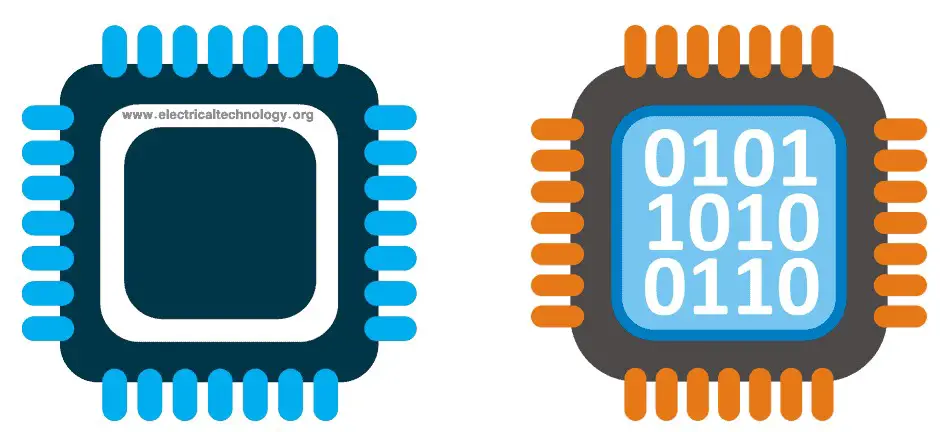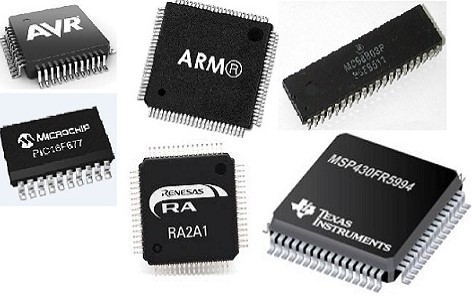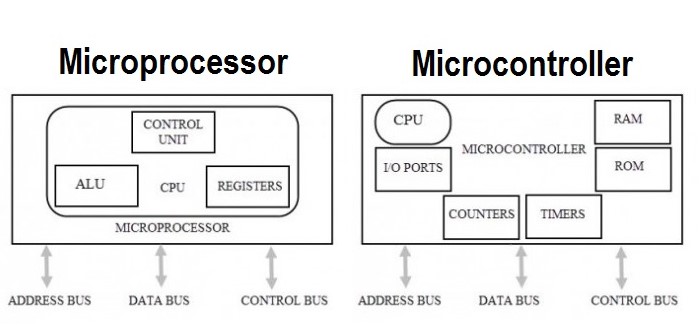The digital age thrives on the backbone of electronic devices, which are primarily powered by two pivotal components: microprocessors and microcontrollers. These components are the brains behind the vast array of gadgets, industrial equipment, and everyday appliances that define modern life. While they might seem similar at a glance, their functions, architecture, and applications differ significantly, marking a fundamental distinction in the world of electronics.
The primary difference between a microprocessor and a microcontroller lies in their structure and intended purpose. A microprocessor is essentially the central processing unit (CPU) of a computer, designed to execute a list of operations and handle complex computations. On the other hand, a microcontroller is an all-encompassing integrated circuit designed for specific control operations, equipped with memory, a processor, and programmable input/output peripherals within a single chip.
Understanding these differences is crucial for engineers, hobbyists, and technologists who design, develop, and work with electronic systems. The choice between a microprocessor and a microcontroller depends on the requirements of the project, including processing power, energy efficiency, cost, and the need for on-chip peripherals. This distinction not only influences the hardware architecture of a device but also its capabilities, energy consumption, and application in everyday technology.

Core Concepts
Microprocessor Basics
Definition and Function
A microprocessor is a computing entity capable of executing a series of instructions to perform detailed operations such as arithmetic, logic, control, and input/output (I/O) operations specified by the software. Its primary role is to act as the brain of computers, extending its functionality to other complex devices that require data processing capabilities.
Key Features and Applications
Key features of microprocessors include:
- High Clock Speed: Enables fast processing of tasks.
- Multitasking Ability: Can run multiple applications simultaneously.
- Upgradeability: Allows for enhancements in performance through hardware upgrades.
Microprocessors find applications in:
- Computing Devices: Such as personal computers and laptops.
- Advanced Gaming Systems: For high-speed game processing.
- Complex Data Processing Systems: In business and scientific research environments.
Microcontroller Basics
Definition and Function
A microcontroller integrates a microprocessor with additional features like memory and input/output peripherals on a single chip. It is designed to control a specific task within an embedded system, making it a self-contained and efficient unit for managing specific operations.
Key Features and Applications
Key features of microcontrollers include:
- Integrated System: Combines CPU, memory, and peripherals.
- Low Power Consumption: Optimized for energy efficiency.
- Cost-effective: Lower overall system cost due to integration.
Microcontrollers are used in:
- Embedded Systems: Like home appliances and medical devices.
- Automotive Electronics: For controlling car systems.
- Consumer Electronics: In gadgets like cameras and TVs.
Architectural Differences
Hardware Structure
The hardware structure of microprocessors and microcontrollers differs significantly in terms of CPU core, memory management, and input/output interfaces.
CPU Core
The CPU core in microprocessors is designed for high-speed processing and multitasking. In contrast, microcontrollers have a CPU core optimized for controlling operations and handling specific tasks efficiently.
Memory Management
Microprocessors utilize external memory for storing data and programs, offering flexibility and capacity expansion. Microcontrollers, however, incorporate internal memory, simplifying design and enhancing speed at the cost of fixed storage capacity.
Input/Output Interfaces
Microprocessors require external components for I/O operations, while microcontrollers include built-in I/O ports. This integration in microcontrollers facilitates direct control of external devices.
Integration and Compactness
System-on-Chip (SoC) Approach
Microcontrollers are examples of the System-on-Chip approach, where all necessary computing and control components are integrated into a single chip. This compactness is ideal for applications where space and power efficiency are critical.
Peripheral Integration
Microcontrollers excel in peripheral integration, offering built-in support for common peripherals like ADCs, timers, and communication interfaces. This contrasts with microprocessors, which may require additional chips for these functions.
Performance and Power
Processing Power
- Clock Speed Comparison: Microprocessors typically operate at higher clock speeds, providing greater processing power.
- Computational Abilities: Microprocessors excel in complex computations and multitasking, while microcontrollers are optimized for specific tasks.
Energy Efficiency
- Power Consumption Patterns: Microcontrollers are designed for low power consumption, making them suitable for battery-operated devices.
- Suitable Applications Based on Power Needs: Microcontrollers are preferred in energy-sensitive applications, whereas microprocessors are chosen for performance-intensive tasks.
Application Fields
Microprocessor Applications
- Personal Computers and Servers: Where processing power and multitasking are paramount.
- Complex Data Processing Systems: Utilized in areas requiring extensive data manipulation and analysis.
Microcontroller Applications
- Embedded Systems: Ideal for controlling specific functions within a device, such as in automotive electronics.
- Consumer Electronics: Used in products requiring specific control operations, ensuring efficiency and cost-effectiveness.

Development and Programming
Programming Languages and Tools
Common Languages for Microprocessors
Microprocessors, the brains behind computers and complex data-processing systems, require programming languages that can leverage their high computational capabilities. Languages such as C++, Java, and Assembly Language are commonly used for microprocessor programming. Each language offers unique advantages:
- C++ is favored for its object-oriented features and efficiency, making it suitable for developing complex software systems.
- Java is used for its platform independence, allowing developers to write code once and run it on any device with a Java Virtual Machine (JVM).
- Assembly Language provides direct hardware control, enabling programmers to optimize system performance.
Common Languages for Microcontrollers
Microcontrollers, designed for specific control tasks, often utilize languages like C, Assembly, and in some cases, Python for higher-level applications. These choices reflect the need for direct hardware interaction, efficiency, and simplicity in programming:
- C is predominant due to its ability to combine high-level language features with the capability for low-level programming, crucial for embedded systems.
- Assembly Language is used for tasks requiring maximum efficiency or direct hardware manipulation.
- Python is increasingly popular for simpler microcontroller boards due to its ease of use and readability, especially in educational contexts or DIY projects.
Development Environment
Integrated Development Environments (IDEs)
IDEs are crucial tools that provide a comprehensive environment for software development. For microprocessor and microcontroller programming, IDEs like Eclipse, Arduino IDE, and Visual Studio are widely used. They offer features such as:
- Code editing
- Compilation
- Debugging capabilities
These IDEs support various programming languages and frameworks, facilitating the development of applications ranging from simple embedded systems to complex operating systems.
Software and Hardware Debugging Tools
Debugging is a critical step in the development process. Software tools like GDB (GNU Debugger) and hardware tools like JTAG (Joint Test Action Group) interfaces are essential for identifying and fixing errors. These tools allow developers to:
- Inspect program execution in real time
- Modify program state for testing
- Access hardware components directly to troubleshoot issues
Cost and Accessibility
Initial and Maintenance Costs
Comparison of Upfront Costs
The initial cost of microprocessors and microcontrollers varies based on their capabilities and applications. Generally, microcontrollers are less expensive than microprocessors due to their integrated design and focus on specific tasks. However, the total cost of a project also includes development tools, programming resources, and the necessary peripherals, which can narrow the cost gap.
Long-Term Maintenance Expenses
Maintenance costs are influenced by the complexity of the system, availability of replacement parts, and need for software updates. Microcontroller-based systems often have lower maintenance costs, as they are usually designed for specific, stable tasks. In contrast, microprocessor-based systems might require more frequent updates and hardware replacements, leading to higher long-term expenses.
Availability and Sourcing
Market Availability
Both microprocessors and microcontrollers are widely available from numerous manufacturers and distributors. However, the availability of specific models can be affected by factors like production cycles, market demand, and technological advancements.
Component Sourcing Challenges
Sourcing components can be challenging due to supply chain issues, obsolescence, and compatibility concerns. Developers must consider these factors, especially for large projects or products with long lifecycles, to ensure that their chosen components will be available for the duration of their project.
Choosing the Right Component
Project Requirements Analysis
Selecting between a microprocessor and a microcontroller starts with a thorough analysis of the project’s requirements. Key considerations include:
- Processing power needed for the application
- Energy efficiency requirements
- Size and cost constraints
- Peripheral needs
This analysis helps in narrowing down the choice to the component that best fits the project’s needs.
Assessing Performance Needs
Performance needs vary widely across different applications. High-end computing tasks may necessitate the use of microprocessors, while simpler control-oriented tasks are well-suited to microcontrollers. Evaluating the complexity of the task and the data processing requirements is essential.
Power Consumption Considerations
Power consumption is a critical factor, especially for portable or battery-operated devices. Microcontrollers generally offer better power efficiency, making them ideal for applications where power conservation is a priority.
Cost-Benefit Analysis
A cost-benefit analysis helps in weighing the initial and ongoing costs against the performance and features of microprocessors and microcontrollers. Factors such as long-term sustainability, maintenance expenses, and energy consumption play a significant role in this evaluation.
Long-Term Sustainability
Considering the future-proofing of a project is crucial. This includes evaluating the scalability of the component, support for software updates, and the availability of replacement parts. A choice that balances current needs with future growth and changes ensures long-term sustainability.
FAQs
What is a Microprocessor?
A microprocessor is a computer processor that incorporates the functions of a computer’s central processing unit (CPU) on a single integrated circuit (IC) or at most a few integrated circuits. It is a multipurpose, programmable device that accepts digital data as input, processes it according to instructions stored in its memory, and provides results as output. Microprocessors are the heart of PCs, laptops, and many advanced electronic devices, offering substantial computational power for various applications.
What is a Microcontroller?
A microcontroller is a compact integrated circuit designed to govern a specific operation in an embedded system. It includes a processor, memory, and programmable input/output peripherals. Microcontrollers are optimized for controlling electronic devices and are commonly found in appliances, vehicles, and mobile phones. They are designed to be efficient and cost-effective, making them ideal for dedicated, repetitive tasks.
How Do Microprocessors and Microcontrollers Differ in Application?
Microprocessors and microcontrollers differ significantly in their applications due to their design and capabilities. Microprocessors are used in systems requiring high computational power and flexibility, such as personal computers, servers, and complex industrial systems. Conversely, microcontrollers are employed in embedded systems where integration, efficiency, and cost are key considerations. These include household appliances, automotive electronics, and consumer gadgets.
Which is More Energy Efficient, Microprocessor or Microcontroller?
Microcontrollers are generally more energy-efficient than microprocessors. This is because microcontrollers are designed to perform specific tasks and can be optimized for low power consumption. They integrate all necessary components, including the CPU, memory, and I/O peripherals, on a single chip, reducing the power required for communication between components. This makes them ideal for battery-operated devices and applications where power efficiency is crucial.
Conclusion
The distinction between microprocessors and microcontrollers is a cornerstone of electronic design, determining the capabilities and applications of countless devices. At their core, microprocessors offer raw computational power suitable for complex processing tasks, whereas microcontrollers provide a cost-effective, integrated solution for controlling specific functions. Understanding their differences enables designers to make informed choices, tailoring electronic systems to meet precise needs efficiently and effectively.
In navigating the future of electronics, the choice between microprocessor and microcontroller will continue to play a pivotal role. As technology advances, the lines may blur with components offering both high performance and integrated functionality. However, the fundamental principles of choosing the right component based on the application’s requirements, energy consumption, and cost will remain essential in driving innovation and functionality in the electronic world.

